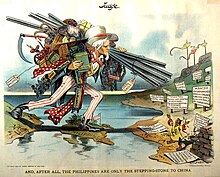Uncle Sam

Uncle Sam is the most famous national allegory in the United States . He was a popular advertising figure, but wasn't officially recognized until 1961 by a Senate resolution . Uncle Sam is used and understood worldwide.
Outside the United States, Uncle Sam is a personified caricature of that country. Use of the name Uncle Sam often reflects a critical attitude towards the government or culture of the United States.
features
Basically, the following features characterize the visual representation of the figure:
- Uncle Sam is a skinny, older man with white skin, white hair, goatee and mostly serious facial expressions.
- He wears the national colors of the USA on his body, a dark blue jacket with red and white striped trousers.
- His top hat is usually decorated with the stars and stripes .
- Many illustrations show his initials US , which also stand for "United States".
History of origin
The figure probably dates back to the time of the British-American War of 1812. It is said to have been named after Samuel Wilson III (1766–1854), a manufacturer of canned meat in Troy , New York .
Tradition cites an incident on an army base in the northern part of the state of New York as the origin of the name, which has become symbolic : According to this, the soldiers there received barrels with meat supplies, which were marked with the letters US. They are the first in the fun as the initials of their suppliers in Troy, U NCLE S Samuel Wilson, viewed, and later to the United States (English: United States) have transferred who cared for these deliveries.
This interpretation was recognized in the Senate resolution of 1961, which also officially laid down the meaning of the figure. Nevertheless, there are various objections to this derivation. It should therefore not be possible to finally clarify the origin of the name.
Uncle Sam became popular through the cartoonists and journalists of the 20th century, especially through the "father of American cartoons" Thomas Nast . Since Uncle Sam seemed more real and pragmatic than the character Columbia , Thomas Nast and his colleagues preferred him in their caricatures and on posters . In the course of the 20th century, Uncle Sam replaced Columbia as the national figure of the United States.
Uncle Sam owes its well-known appearance to the graphic artist James Montgomery Flagg , who had Uncle Sam advertise the military with the words I Want You for US Army during the First World War (see top picture). The US motif from 1917 was a modification of the British poster Lord Kitchener Wants You from 1914. It was used again during World War II.
National symbol

Alongside the Statue of Liberty , Uncle Sam is currently the most important national symbol of the United States. In it, the state , nation and people of the USA appear vividly in human form, which facilitates identification . It can be characterized as a pictorial representation of a (positive) national self-image . Other national figures , such as Brother Jonathan from the early days of the States or the female figure of Columbia , do not come close to his symbolic power in our time .
In addition, however, the figure becomes the starting point for criticism, especially in caricatures. While Uncle Sam is treated as a respectable figure within the USA and assessed as the “conscience of the nation”, the cartoonists of other countries take him far more negatively: Especially in an anti-US American context, he bears the features criticized and then embodies national arrogance or imperialist tendencies.
In addition to general criticisms that are directed against the national idea and its representation, the objections to Uncle Sam are directed primarily against his quality as a white man. In recent times, artists have tried on various occasions to redesign the appearance of Uncle Sam, with the top hat retained as a distinguishing mark. Some versions also have similarities with Abraham Lincoln .
Derivatives and transfers - “Uncle Sam” as a brand
Symbolic figure
Due to his great popularity of the symbol figure outside of the USA, Uncle Sam stands for the American way of life in Europe and for characteristics that are considered typically US-American from the outside perspective, e.g. B. Drive-in culture , fast food , American football , etc. For friends and fans of such cultural elements, the figure and the name Uncle Sam are used again and again as a product name, mascot or brand name.
Cartoon character
Uncle Sam appears in superhero comics at the US publisher Quality Comics and its legal successor DC Comics . His superhuman strength and invulnerability is proportional to the confidence of the citizens of the United States he represents in the ideals of freedom and independence. The comics are u. a. published on DC label Vertigo .
Web links
Individual evidence
- ↑ Alexander Emmerich: History of the USA. Theiss, Stuttgart 2008, ISBN 978-3-8062-2192-3
- ^ Entry on Uncle Sam in DCPedia , accessed on July 20, 2011
- ↑ Irvine Alex et al. a., Die Vertigo Enzyklopädie, Panini Verlags GmbH, Stuttgart December 2008, 1st edition, p. 186 (Uncle Sam)
